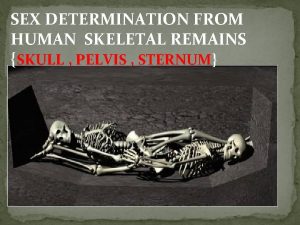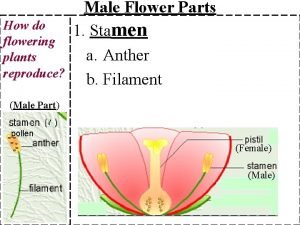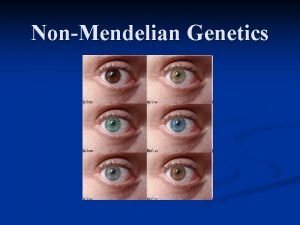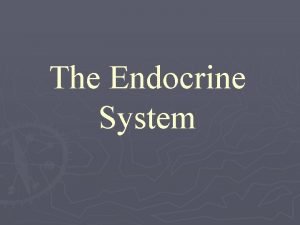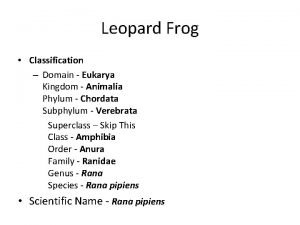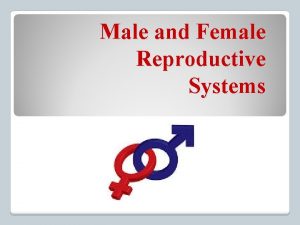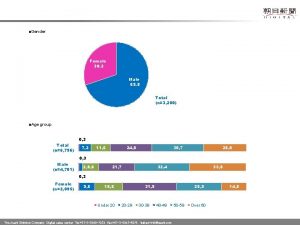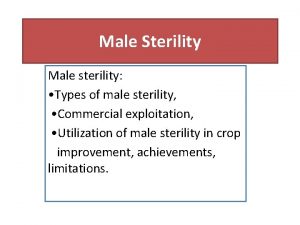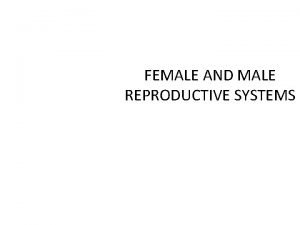Total Gender Female Male Total Female Male Total












- Slides: 12


ΔΗΜΟΓΡΑΦΙΚΑ ΚΑΙ ΚΛΙΝΙΚΟΠΑΘΟΛΟΓΙΚΑ ΧΑΡΑΚΤΗΡΙΣΤΙΚΑ Total Gender Female Male Total Female Male Total N (%) 246 (100) 125 (50. 8) 121 (49. 2) Median age at diagnosis 57 (18 -82) 58 (18 -79) 55 (21 -82) Clinical Symptoms 27 (21. 6%) 32 (26. 4%) 59 (24%) Incidental Diagnosis 44 (35. 2) 32 (26. 4) 76 (30. 9) Referral by another specialty 54 (43. 2) 57 (47. 1) 111 (45. 1) p=0. 455 P=0. 168 P=0. 608

Primary site Gastrenteropancreatic Stomach Antrum Fundus Corpus Antrum Pancreas Head Tail Body Duodenum Jejunum Ileum Appendix Colon Rectum Head and Neck Pheochromocytoma Lung Typical Atypical Unknown Primary Differentiation Grade † Well Moderate Poor Ki-67 LI‡ <2% 2 -20% No of patients 156 (63. 4) 54 (35%) 11 (20. 4) 6 (11. 1) 37 (68. 5) 11 (20. 4) 36 (23%) 20 (55. 6) 10 (27. 8) 6 (16. 7) 8 (5%) 5 (3%) 10 (6%) 17 (11%) 8 (5%) 18 (12%) 44 (17. 9) 6 (2. 4) 16 (6. 5) 10 (62. 5) 6 (37. 5) 24 (9. 8) 132 (58. 4) 73 (32. 3) 21 (9. 3) No of patients 166 56

Most common diagnostic procedures and yield of tumor detection Performed Positive yield Diagnostic procedures N (%) Computed Tomography 202 (82. 1) 117 (58. 5) Octreoscan Chest x-ray Gastroscopy Abdominal ultrasound Colonoscopy Magnetic Resonance Bone Scan Endoscopic Ultrasound Endoscopic capsule PET MIBG Bronchoscopy Enteroclysis 156 (63. 4) 152 (61. 8) 126 (51. 2) 90 (36. 6) 85 (34. 6) 59 (24. 0) 27 (11. 0) 16 (6. 5) 11 (4. 5) 10 (4. 1) 5 (2. 0) 79 (50. 6) 20 (13. 2) 65 (51. 6) 50 (55. 6) 27 (30. 0) 63 (75. 0) 12 (20. 7) 20 (74. 1) 3 (18. 8) 9 (81. 8) 6 (60. 0) 7 (70. 0) 3 (60. 0)

Rate of positive results according to diagnostic procedures used for staging according to primary site Diagnostic Procedure Octreoscan Head & Neck n (%) 5 (31. 3) Bronchial n (%) GEP n (%) 5 (45. 5) 59 (55. 1) MIBG Computed Tomography 1 (100. 0) 7 (21. 2) 0 (0) 1 (6. 3) 0 (0. 0) 71 (56. 8) Magnetic Resonance 2 (18. 2) 0 (0) PET x-Ray 0 (0) 33 (100. 0) Bone Scan Abdominal Ultrasound Pheochromocyto ma n (%) 1 (50. 0) Unknown Primary n (%) 7 (35. 0) p 0. 219 1 (20. 0) 0 (0) 2 (66. 7) 4 (18. 2) 0. 429 <0. 001 16 (30. 8) 0 (0) 3 (21. 4) 0. 651 0 (0) 1 (33. 3) 82 (97. 6) 0 (0) 2 (100. 0) 14 (82. 4) 0. 182 <0. 001 18 (81. 8) 5 (100. 0) 9 (75. 0) 2 (66. 7) 7 (77. 8) 32 (49. 2) 3 (75. 0) 0 (0) 9 (81. 8) 1 (7. 7) 0. 985 <0. 001 Gastroscopy 4 (100. 0) 3 (100. 0) 42 (40. 0) 0 (0) 12 (85. 7) <0. 001 Colonoscopy 2 (100. 0) 44 (62. 0) 0 (0) 15 (100. 0) 0. 003 Endoscopic Capsule Enteroclysis Endoscopic Ultrasound 0 (0) 1 (100. 0) 0 (0) 7 (70. 0) 1 (25. 0) 4 (19. 0) 0 (0) 6 (100. 0) 1 (100. 0) 2 (40. 0) 0. 250 0. 400 0. 220 Bronchoscopy 0 (0) 3 (100. 0) 0. 008



Distribution of Ki-67 labelling index according to type of treatment & responses

Primary surgery and debulking procedures in NET patients Primary Surgical Excision¥ Head and Neck Lung GEP Pheochromocytoma Unknown Primary Radical 40 8 110 4 2 Total number of patients 128 65 49 1 pheo, 3 lung, 11 UP, 34 GEP Number of patients Primary (all Ki 67<20%) Liver Metastasectomy 6 1 Lung, 4 GEP, 1 UP Chemoembolization Radiofrequency Ablation Other Number of patients with lung metastases 3 4 2 6 Type of Surgery Open Surgery Endoscopic/Laparoscopic Excision Number of patients with liver metastases Treatment of Liver Metastases Treatment of Lung Metastases 1 surgical excision Non Radical 4 2 20 2 1 GEP GEP 1 lung, 1 UP, 4 GEP 1 lung



The researchers thank IPSEN EPE! I thank you for your attention!
 Strategic gender needs and practical gender needs
Strategic gender needs and practical gender needs Sloped forehead skull
Sloped forehead skull Female and male parts of a flower
Female and male parts of a flower Red eyed female and white eyed male
Red eyed female and white eyed male Associative learning
Associative learning Major endocrine glands male and female
Major endocrine glands male and female What are the male parts of a flower
What are the male parts of a flower Male gaze définition
Male gaze définition Domain of a frog
Domain of a frog What is this flower?
What is this flower? Os coxae
Os coxae Male and female hormones
Male and female hormones How to do a punnett square for color blindness
How to do a punnett square for color blindness

